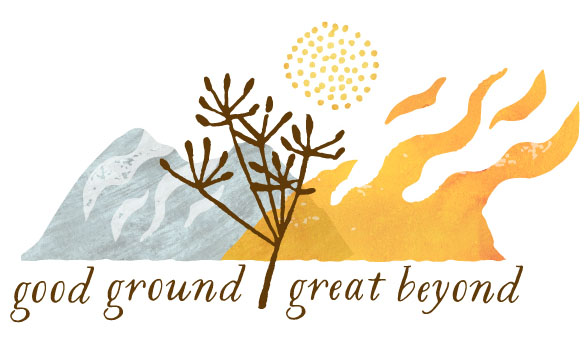Taking death to heart
Hildegard Von Bingen
Thomas Merton and the Dalai Lama
Gravettian Shaman burial
I had a conversation with a friend in her mid sixties. We were talking about her long and loving marriage and I had asked how she and her husband talk about death. She paused, made a clicking sound with her mouth and, exasperated, said, “Um, we don’t talk about it. We spend our time LIVING?!” I had no inclination to lecture on the symbiotic nature of life and death. So I briefly shared my perspective on the usefulness and power of discussing death and we carried on in our conversational meander.
Over time, she became somewhat of a champion of good death planning and the merits of green burial. I know our conversation had an impact on her, not necessarily what I said, but how she felt and saw her own response. It was a mirror of her mind. She felt her resistance, questioned it and had insight into the roots of that resistance.
It’s interesting.
Working in the world of hospice and in creative forms of death work and advocacy, I have seen this process of resistance, insight and change in countless forms. Coming to clearly see a stuck place is like having a very active and tiring dream where someone pushes you awake. You abruptly find yourself in the simplicity of a moment, in your body. And you see the dream in juxtaposition to clearer reality. For a moment or two or three you feel the contrast, what was fabricated and what is true.
Sometimes our cultural backdrop can give the current trends in death education and work a sheen of self-help or vitamin sales: “Do this and you will be happy.” Certainly, “do this to be happy” is not really the point, more a deceptive twist on a fundamental call. Our sleep is thick and remaining sedated does not serve our living in this world. So all the ways folks remind us that death has a seat at the table serve as a nudge. People talking and teaching often about death in it’s multi-facets can be a skillful means. Our death distancing slumber has been Rip-Van-Winkle-heavy. We need varieties of shamans banging pots, being startling or persistent enough that we rouse to meet the mirror of our mind, think for a moment, tend to the real, learn. In the belly of all chaos, life is conspiring to wake us up.
Heeding the nudge of wakefulness also requires some effort.
It demands concerted contemplation.
Contemplation, taking very specific ideas to heart, repetitively and intentionally as practice, is an integral part of my meditation lineage. It is a gentler variation of shamans banging pots, stirring us from sleep. Contemplative engagement and practice has a powerful function in listening well to life and death.
Buddhist teachings talk very directly about suffering and the realities of embodied existence, which include sickness and death. The tradition offers practices and contemplations aimed at feeing into these realities in order to know what they are, what they’re made of; to know our fears and, what those are made of. Knowing in this way isn’t a brooding pit of obsession, it is a learning in order to grow, from seed to sprout to oak to woods. To contemplate is to feel into something, to ponder and feel, to breath and see the interconnections, notice the distracting thoughts and old stories then come back to the contemplation at hand. The knowing that results from this sort of engagement, from sitting with something and seeing it’s size, is what it means to take something to heart. It initiates a process of disempowering our fabrications and fears by seeing they have no substance.
Buddhism is not alone in having contemplative practice as an integral part of it’s tradition. Christianity offers traditions of contemplative practice. Teachers like Father Thomas Keating and Thomas Merton helped guide people in taking difficult realities to heart as a way of opening the heart. The Christian mystic Hildegard Von Bingen, wrote, “you understand so little of what is around you because you do not use what is within you.” (from her book, Scivias). Rabbi Abraham Heschel’s book the Sabbath is full of beautiful contemplations on Time and sacredness. The mystical Sufi poetry of Rumi and Hafiz direct people’s minds to the nature of love, the nature of suffering, the wakefulness available through chaos and change.
Contemplation helps us see the shape of things we may have once averted. Seeing deeper than our fabrications allows real insight and wisdom to arise and expand. That is life conspiring to wake us, the fact that not only are our fears less substantial, more fluid, ephemeral and changing, but they are often doors too. What we fear and what we deeply long for are essentially interconnected. We and our world evolve in our willingness to take all experience to heart: the seemingly good, bad and all the hodgepodge.
Let the shamans bang their pots. Invite them in. Let them wake you.
Shamans can be outrageous, discomfiting or unassuming. Some shamans are jesters, fearlessly talking about the things we’re too scared to name. Some are gentle, some fiery. Some look like wild artists, like pure color or music. Some shamans look like less well-traveled paths, like intuitions, like sudden opportunities. Some look like loss, like dissolutions or discomfort. Some look like the night, the novel, the poem. Some look like the empty room beckoning you to be still and quiet long past fickle boredom and impatience. Some shamans look like a particular sunset, the colors that impossibly melt, overwhelm and break your heart, coaxing you alert, soft and in awe, engulfed in the expanse beyond distracting thoughts.



